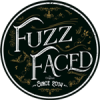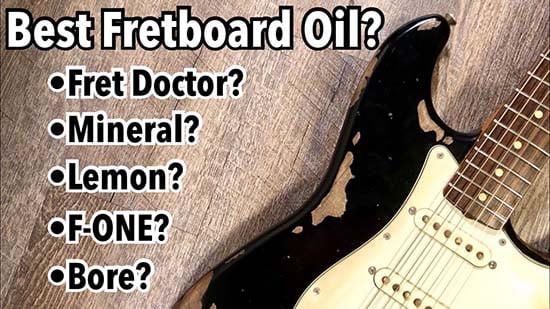But to be honest, not everybody like the way that stuff feels afterwards, how it always seems to manage to migrate to the back of the neck, and not everybody had the need for its rigorous, alcohol-like cleansing properties.
Putting something wet on your guitar is scary, so I did what I do, and vastly over-researched, rather than simply used the first of, the alternatives that came up. It turns out people are dumping all sorts of my-tech-swears-by-it home remedies into their fretboards. Among them:
In addition to the many commercially available options, of course, like:
Putting something wet on your guitar is scary, so I did what I do, and vastly over-researched, rather than simply used the first of, the alternatives that came up. It turns out people are dumping all sorts of my-tech-swears-by-it home remedies into their fretboards. Among them:
- Boiled Linseed Oil
- Gunstock Oil
- Bore Oil
- 3-in-1 Oil
- Olive Oil
- Mineral Oil
- Nose Grease
- Old English Lemon Oil
- Pledge
- Motor Oil
In addition to the many commercially available options, of course, like:
- Fret Doctor
- Fast Fret
- Guitar Honey
- Fretboard Juice
|
Sometimes life takes you to CVS three minutes before closing, running up and down the aisles seeking laxatives for your guitar.
I had a dry, light-colored rosewood fretboard that it seemed could use a little treatment. Since I’ve been little there’s only been one thing you put on fretboards to condition, clean or “feed” them: lemon oil. |
I’d like to save your time. Though opinions vary widely on how wise it is to use several of these substances on guitar necks, mineral oil emerges as the safest, simplest, cheapest option for worry-free fretboard oiling (and we are talking oiling here, not cleaning; conditioning, darkening, protecting the wood). Some love to treat their guitars to a nice virgin olive oil; others will counter that any such food-based liquid will eventually go rancid. Some have been happily using boiled linseed oil for years, nabbed from places like Home Depot; from other quarters you’ll hear how things like linseed oil and tung oil actually build up a finish, which might look nice and shiny but isn’t what you want to be doing to a fretboard. Even lemon oil, which in its instrument cleaning incarnation has nothing to do with lemons, it is said can actually dry out a fretboard once evaporated (and its solvents can possibly loosen your frets and inlays)! Mineral oil has no such cautionary tales. Like all these oils, though, it is not for use on maple fretboards, but unfinished dark woods like rosewood and ebony.
What to do
- Remove your strings.
- Dab a little spot of mineral oil on a clean rag.
- Rub it into the fretboard.
- Let it sit 10 or 15 minutes.
- Rub off all excess with a clean, dry rag. Be thorough here.
- Restring when dry, optionally waiting overnight to be sure.
Where to buy it, where not to buy it
Most of those expensive little specialist snake oil bottles sold in music stores, including the ubiquitous “lemon oil”, are, in fact, largely mineral oil, plus some solvents and fragrance, and are certainly the most costly way to get the stuff. The least? That I could find: laxative! That’s when you find yourself at a pharmacy, buying a big bottle of intestinal lubricant for the sake of guitar maintenance, and you perhaps have to do a little stock taking.
It cost around $5 for a pint of what I assume to be, as it is sold for consumption by humans, high grade mineral oil. A pint! Like other fretboard treatments, you use a tiny dab on a cloth. That is going to last forever. For the sake of being able to look the cashier in the eye after bursting into the store as though this personal plumbing remedy was required with alarming urgency, I almost wimped out in favor of the less socially stigmatizing baby oil, which is simply mineral oil and fragrance (in fact I showed up in a hurry because I’d learned only minutes before that mineral oil could be had at drug stores, and, ever impatient, wanted to grab some before they closed). But no — I wanted the purest. The drinking type may be sold in one of the least pleasant sections of the pharmacy and suggest you are blocked up like a New Orleans storm drain, but the only additional ingredient it lists is Vitamin E. Pretty pure.
It cost around $5 for a pint of what I assume to be, as it is sold for consumption by humans, high grade mineral oil. A pint! Like other fretboard treatments, you use a tiny dab on a cloth. That is going to last forever. For the sake of being able to look the cashier in the eye after bursting into the store as though this personal plumbing remedy was required with alarming urgency, I almost wimped out in favor of the less socially stigmatizing baby oil, which is simply mineral oil and fragrance (in fact I showed up in a hurry because I’d learned only minutes before that mineral oil could be had at drug stores, and, ever impatient, wanted to grab some before they closed). But no — I wanted the purest. The drinking type may be sold in one of the least pleasant sections of the pharmacy and suggest you are blocked up like a New Orleans storm drain, but the only additional ingredient it lists is Vitamin E. Pretty pure.
Does it work?
The actual effects of the stuff on dry rosewood were fair but, like most of these things, did not seem long lasting. Initially, yes, it darkened and sort of glossed the wood, but a month or so later it’s looking light and porous again. Just as light? I can’t say. In the very short term, one or two days, I was not sure I cared for the unexpected effect it had on tone, a bit of top-end damping and curtailing of resonance. While I freely admit I might have invented this psychosomatically as a worryer and overthinker, it would make sense: you’re blocking wood pores that were previously open and singing.
Crustier, wizened guitar players who have been around a while tend to show up in discussions of fretboard treatments like this and point out that they are unnecessary; that wood isn’t hungry or thirsty and need not be ‘fed’; that we do these things only for appearance, for ourselves, and the wood is fine just as it is, light or dark. I admit to prejudice, believing dark wood to be good wood. Excepting extreme climatic conditions, they’re probably right, and given that little jolt — “what have I done to the tone?” — and the short-lived benefit to the shade of the wood, I wouldn’t be in the greatest hurry to apply more of it, though it does seem by all accounts the most harmless of substances for this use. The warning label on the back does direct consumers to discontinue use if rectal bleeding occurs — advice I think it’s worth sticking to in this or indeed any other application.
Crustier, wizened guitar players who have been around a while tend to show up in discussions of fretboard treatments like this and point out that they are unnecessary; that wood isn’t hungry or thirsty and need not be ‘fed’; that we do these things only for appearance, for ourselves, and the wood is fine just as it is, light or dark. I admit to prejudice, believing dark wood to be good wood. Excepting extreme climatic conditions, they’re probably right, and given that little jolt — “what have I done to the tone?” — and the short-lived benefit to the shade of the wood, I wouldn’t be in the greatest hurry to apply more of it, though it does seem by all accounts the most harmless of substances for this use. The warning label on the back does direct consumers to discontinue use if rectal bleeding occurs — advice I think it’s worth sticking to in this or indeed any other application.


